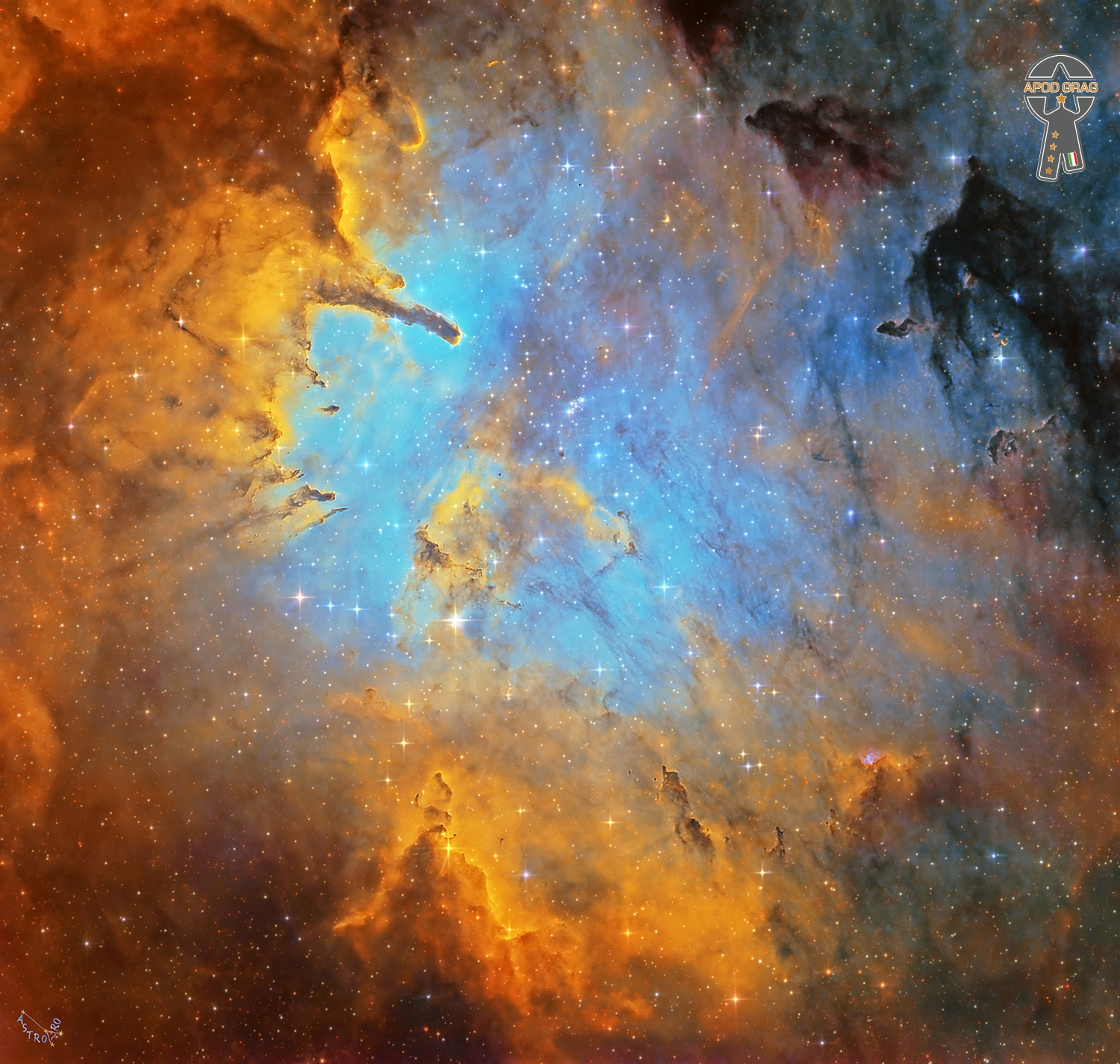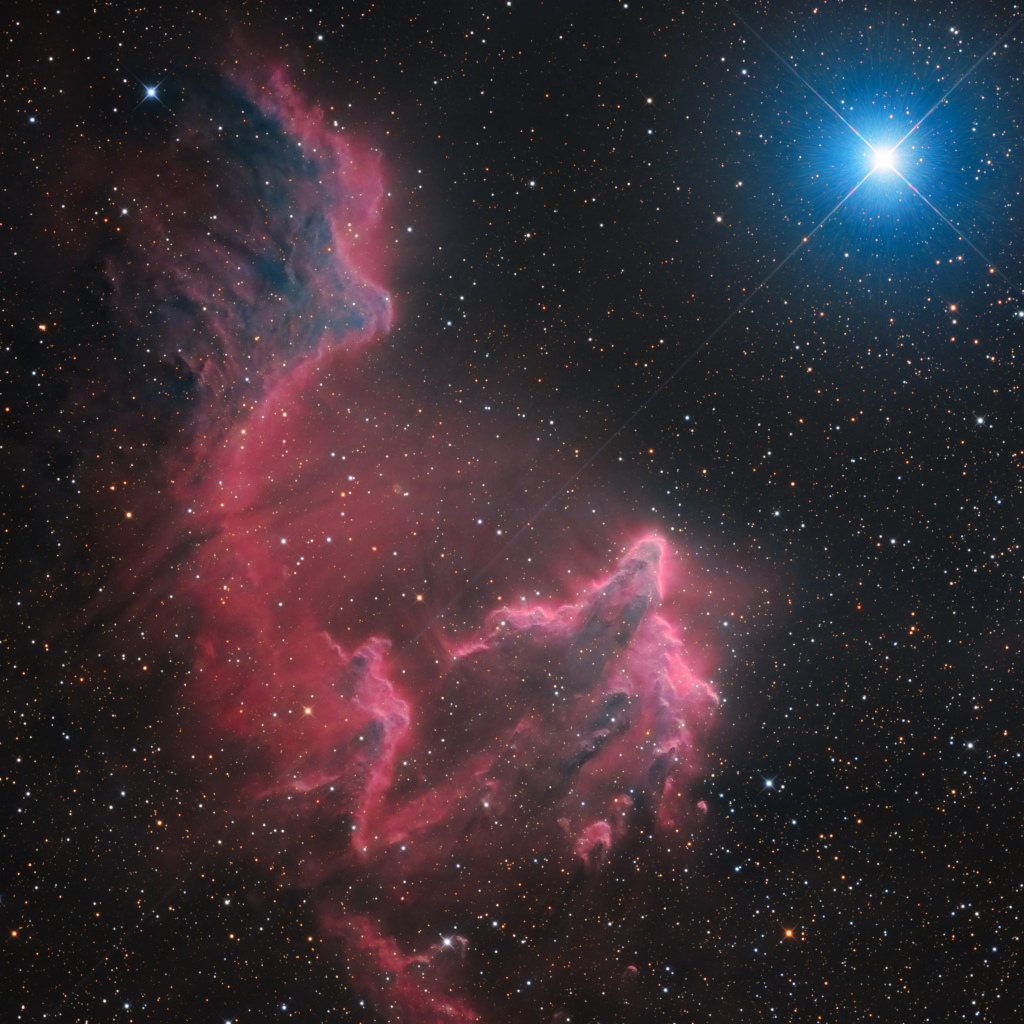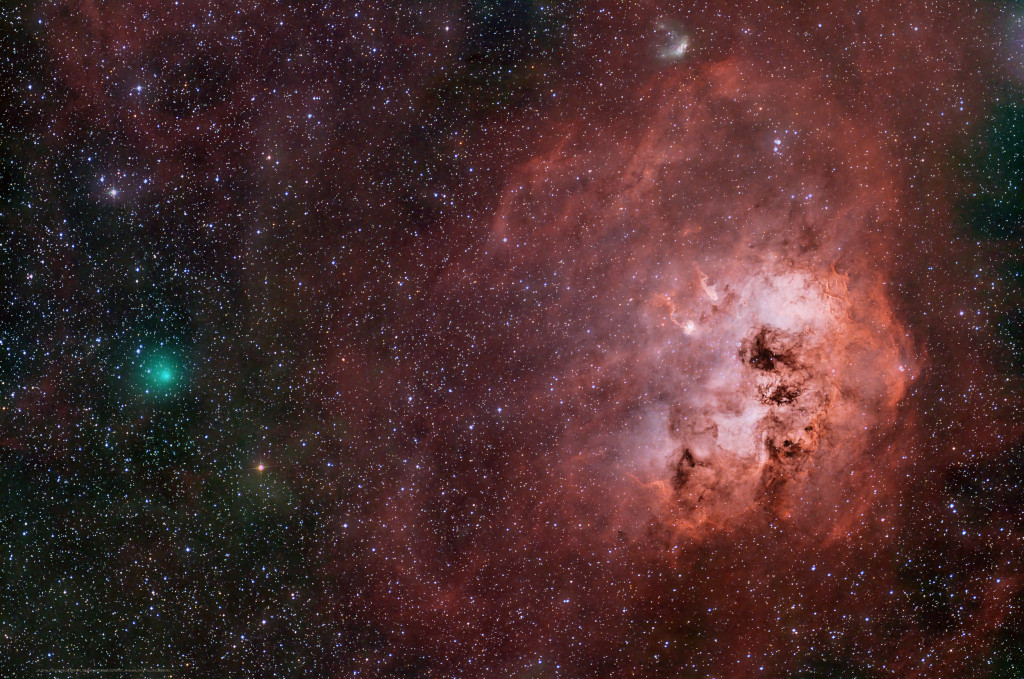Blog
NGC 6820 is a small reflection nebula near the open cluster NGC 6823 in Vulpecula. The reflection nebula and cluster are embedded in a large faint emission nebula called Sh 2-86. The whole area of nebulosity is often referred to as NGC 6820.
M27, the Dumbbell Nebula, is found three degrees to the east, and α Vulpeculae three degrees to the west.
Open star cluster NGC 6823 is about 50 light-years across and lies about 6,000 light-years away. The center of the cluster formed about two million years ago and is dominated in brightness by a host of bright young blue stars. Outer parts of the cluster contain even younger stars. It forms the core of the Vulpecula OB1stellar association.

Denny Laine (born Brian Frederick Hines, 29 October 1944)[1] is an English musician, singer, and songwriter, known as a founder of two major rock bands: The Moody Blues, with whom he played from 1964 to 1966, and Wings, with whom he played from 1971 to 1981. Laine has worked with a variety of artists and groups over a six-decade career, and continues to record and perform as a solo artist. In 2018, Laine was inducted into the Rock and Roll Hall of Fame as a member of The Moody Blues.
more...Peter Allen Greenbaum (29 October 1946 – 25 July 2020), known professionally as Peter Green, was an English blues rock singer-songwriter and guitarist. As the founder of Fleetwood Mac, he was inducted into the Rock and Roll Hall of Fame in 1998. Green founded Fleetwood Mac in 1967 after a stint in John Mayall’s Bluesbreakers and quickly established the new band as a popular live act in addition to a successful recording act, before departing in 1970. Green’s songs, such as “Albatross“, “Black Magic Woman“, “Oh Well“, “The Green Manalishi (With the Two Prong Crown)” and “Man of the World“, appeared on singles charts, and several have been adapted by a variety of musicians.
Green was a major figure in the “second great epoch” of the British blues movement. Eric Clapton praised his guitar playing, and B.B. King commented, “He has the sweetest tone I ever heard; he was the only one who gave me the cold sweats.” His trademark sound included string bending, vibrato, emotionally expressive tone, and economy of style.
In June 1996, Green was voted the third-best guitarist of all time in Mojo magazine. In 2015, Rolling Stone ranked him at number 58 in its list of the “100 Greatest Guitarists of All Time”. Green’s tone on the instrumental “The Supernatural” was rated as one of the 50 greatest of all time by Guitar Player in 2004.
more...John Haley “Zoot” Sims (October 29, 1925 – March 23, 1985) was an American jazz saxophonist, playing mainly tenor but also alto (and, later, soprano) saxophone. He first gained attention in the “Four Brothers” sax section of Woody Herman‘s big band, afterward enjoying a long solo career, often in partnership with fellow saxmen Gerry Mulligan and Al Cohn.
Sims was born in 1925 in Inglewood, California, United States, to vaudeville performers Kate Haley and John Sims. His father was a vaudeville hoofer, and Sims prided himself on remembering many of the steps his father taught him. Growing up in a performing family, he learned to play drums and clarinet at an early age. His brother was the trombonist Ray Sims.
more...Gamma Cassiopeiae shines high in northern autumn evening skies. It’s the brightest spiky star in this telescopic field of view toward the constellation Cassiopeia. Gamma Cas shares the ethereal-looking scene with ghostly interstellar clouds of gas and dust, IC 59 (top left) and IC 63. About 600 light-years distant, the clouds aren’t actually ghosts. They are slowly disappearing though, eroding under the influence of energetic radiation from hot and luminous gamma Cas. Gamma Cas is physically located only 3 to 4 light-years from the nebulae. Slightly closer to gamma Cas, IC 63 is dominated by red H-alpha light emitted as hydrogen atoms ionized by the star’s ultraviolet radiation recombine with electrons. Farther from the star, IC 59 shows proportionally less H-alpha emission but more of the characteristic blue tint of dust reflected star light. The cosmic stage spans over 1 degree or 10 light-years at the estimated distance of gamma Cas and friends.

more...
Richard Bona (born 28 October 1967) is a Cameroon-born American multi-instrumentalist and singer.
Bona Penda Nya Yuma Elolo was born in Minta, Cameroon, into a family of musicians, which enabled him to start learning music from a young age. His grandfather was a griot – a West African singer of praise and storyteller – and percussionist, as his mother was a singer. When he was four years old, Bona started to play the balafon. At the age of five, he began performing at his village church. Not being wealthy, Bona made many of his own instruments: including flutes and guitars (with cords strung over an old motorcycle tank).
His talent was quickly noticed, and he was often invited to perform at festivals and ceremonies. Bona began learning to play the guitar at the age of 11, and in 1980, aged just 13, he assembled his first ensemble for a French jazz club in Douala. The owner befriended him and helped him discover jazz music, in particular that of Jaco Pastorius, which inspired Bona to switch his focus to the electric bass.
more...Keith Anderson CD (28 October 1944 – 27 March 2020), better known by the stage name Bob Andy, was a Jamaican reggae vocalist and songwriter. He was widely regarded as one of reggae’s most influential songwriters.
Anderson was born in Kingston, Jamaica, in October 1944, where his mother worked at Up-Park Camp.At the age of seven he moved to live with his grandmother in Westmoreland. After his grandmother died, his mother gave him away, and he was subject to beatings at the hands of his adoptive parents.
After several years he returned to Kingston to help look after one of his siblings, but to escape beatings from his mother, he tried to get a place at Maxfield Park children’s home by telling them that his mother had died. They both ended up in court, where he was made a ward of the state and returned to Maxfield Park. At the home, he taught himself to play piano, and began singing in the Kingston Parish Church choir. In the local scout troop he met Tyrone Evans, with whom he formed the Binders.
more...Glen Moore (born October 28, 1941) is an American jazz bassist, who occasionally performs on piano, flute and violin.
Moore was born in Portland, Oregon, United States. His performing career began at age 14 with the Young Oregonians in Portland, where he met and played with Native American saxophonist, Jim Pepper. He graduated with a degree in History and Literature from the University of Oregon. His formal bass instruction started after college with Jerome Magil in Portland, James Harnett in Seattle, Gary Karr in New York, Plough Christenson in Copenhagen, Ludwig Streicher in Vienna and Francois Rabbath in Hawaii. His main instrument is an upright bass which was made by Klotz in Tyrol around 1715. He mostly plays it in a personal unique tuning, using a low and a high C string.
Moore is a founding member of Oregon, but worked also regularly with Rabih Abou-Khalil, Vasant Rai, Nancy King and Larry Karush.
more...Performing with Rachel Spiller and Tami Morse Friday 10-27-23 630pm
more...History’s second known periodic comet is Comet Encke (2P/Encke). As it swings through the inner Solar System, Encke’s orbit takes it from an aphelion, its greatest distance from the Sun, inside the orbit of Jupiter to a perihelion just inside the orbit of Mercury. Returning to its perihelion every 3.3 years, Encke has the shortest period of the Solar System’s major comets. Comet Encke is also associated with (at least) two annual meteor showers on planet Earth, the North and South Taurids. Both showers are active in late October and early November. Their two separate radiants lie near bright star Aldebaran in the head-strong constellation Taurus. A faint comet, Encke was captured in this telescopic field of view imaged on the morning of August 24. Then, Encke’s pretty greenish coma was close on the sky to the young, embedded star cluster and light-years long, tadpole-shaped star-forming clouds in emission nebula IC 410. Now near bright star Spica in Virgo Comet Encke passed its 2023 perihelion only five days ago, on October 22.

more...
American jazz bassist, born 27 October 1970. Since moving to New York City in 1993, Carlo De Rosa has had the opportunity to work with many great artists in the Latin and Jazz World. work with a wide variety of artists such as Ray Barretto, Ravi Coltrane, William Cepeda, Vijay Iyer, Bruce Barth, Ed Thigpen.
more...George Wallington (October 27, 1924 – February 15, 1993) was an American jazz pianist and composer.
Wallington was born Giacinto Figlia (some sources give “Giorgio”) in Sicily, and then moved to the United States (New York) with his family in 1925. His father sang opera and introduced his son to classical music, but Wallington listened to jazz after hearing the music of saxophonist Lester Young. He said that he acquired the name Wallington in high school: “I like to wear flashy clothes […] and the kids in the neighborhood would say, ‘Hey, look at Wallington!'” He left school at the age of 15 to play piano in New York.
From 1943 to 1953, Wallington played with Dizzy Gillespie, Joe Marsala, Charlie Parker, Serge Chaloff, Allen Eager, Kai Winding, Terry Gibbs, Brew Moore, Al Cohn, Gerry Mulligan, Zoot Sims, and Red Rodney, and recorded as a leader for Savoy and Blue Note (1950). Wallington toured Europe in 1953 with Lionel Hampton‘s big band. In 1954-60, he led bands in New York that contained rising musicians including Donald Byrd, Jackie McLean, and Phil Woods.
https://www.youtube.com/watch?v=MfC8vdBK9dc&list=PL0q2VleZJVEl3TFB5uDCV6j1dTYu_BEDi&index=2
more...Philip Catherine (born 27 October 1942) is a Belgian jazz guitarist. Philip Catherine was born in London, England, to an English mother and Belgian father, and was raised in Brussels, Belgium. His grandfather was a violinist in the London Symphony Orchestra. Catherine started on guitar in his teens, and by seventeen he was performing professionally at local venues.
He released his debut album, Stream, in 1972. During the next few years, he studied at Berklee College of Music in Boston and with Mick Goodrick and George Russell. In 1976, he and guitarist Larry Coryell recorded and toured as an acoustic duo. The same year, when Jan Akkerman abruptly left Focus, Catherine replaced him in the band. The following year, he recorded with Charles Mingus, who dubbed him “Young Django”. In the early 1980s, he toured briefly with Benny Goodman. He was in trio with Didier Lockwood and Christian Escoudé, then in a trio with Chet Baker. During the 1990s, he recorded three albums with trumpeter Tom Harrell.
more...Babs Gonzales (October 27, 1919 – January 23, 1980), born Lee Brown, was an American bebopvocalist, poet, and self-published author. His books portrayed the jazz world that many black musicians struggled in, portraying disk jockeys, club owners, liquor, drugs, and racism. “There are jazz people whose influence can be described as minor,” wrote Val Wilmer, “yet who are well-known to musicians and listeners alike … You’d have to be hard-pressed to ignore the wealth of legend that surrounds Babs Gonzales.” Jazz writer Jack Cooke explained that Gonzales “assumed the role of spokesman for the whole hipster world… [becoming] something more than just a good and original jazz entertainer: the incarnation of a whole social group.”
Gonzales was born Lee Brown in Newark, New Jersey, United States. He was raised solely by his mother Lottie Brown alongside two brothers. Of his nickname, Gonzales explained, “my brothers are basketball players… there was a basketball star in America named Big Babbiad, and so they were called Big Babs, Middle Babs, and I’m Little Babs.” As a young man, Gonzales worked as band boy for swing bandleader Jimmie Lunceford, after which he relocated to Los Angeles. To circumvent racial segregation, Gonzales wore a turban and used the pseudonym Ram Singh, passing as an Indian national.
more...While not as formulaic as sevillanap, alegria dance accompaniment does have a set of distinct “song parts” which, in more traditional arrangements, are often assembled in a predictable order. Many of the same principles apply to solo instrumental arrangements as well.
Structure and Compas
The basic structure of alegria por baile (“for dance”) can be schematized like this:
- Intro
- Copla (verse) & Falseta (guitar melody)
- Footwork
- Silencio
- Castellana
- Escobilla
- Buleria
Within this basic schema, sections can be rearranged, doubled, or eliminated altogether.
The compas of alegria is based in 12s and, like solea, is accented on the 3, 6, 8, 10, and 12 beats:
more...
More Posts
- Ray Mantilla Day
- Cal Green Day
- World Music with ESTRELLA MORENTE
- Daily Roots with Sizzla
- The Cosmos with NGC 5426/27
- Eric Reed Day
- Lalo Schifrin
- Skip James Day
- World Music with Alekos K. Vretos
- Daily Roots with Ijahman Levy
- The Cosmos with M16
- Eric Dolphy Day
- Lazy Lester Day
- World Music with Obo Addy
- Daily Roots with Bob Marley
- The Cosmos with Fleming 1
- Ernest Ranglin Day
- Billy Drummond Day
- World Music with Lela Tataraidze
- Daily Roots with the Skatalites